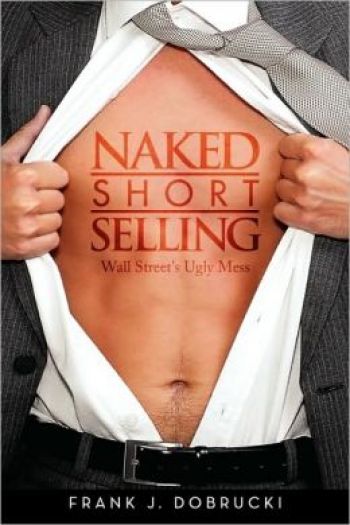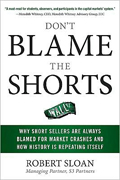Constituency against and for Naked Short
Book Review: Two authors take opposite sides in debate
- |
- Written by Ed Blount
- |
- Comments: DISQUS_COMMENTS
 Naked Short Selling: Wall Street’s Ugly Mess, by Frank Dobrucki, 240 pp., Crestview Press, Las Vegas, Nev.
Naked Short Selling: Wall Street’s Ugly Mess, by Frank Dobrucki, 240 pp., Crestview Press, Las Vegas, Nev.
Naked Short Selling: Wall Street’s Ugly Mess, by Frank Dobrucki, 240 pp., Crestview Press, Las Vegas, Nev. and Don’t Blame the Shorts: Why Short Sellers are Always Blamed for Market Crashes and How History is Repeating Itself, by Robert Sloan, 272 pp., McGraw-Hill, New York
He believes that his Las Vegas-based company, Global Links Corporation, was very nearly destroyed by market manipulators in 2005. To make his point, Mr. Dobrucki has written and self-published Naked Short Selling: Wall Street’s Ugly Mess (Crestview Press, Las Vegas, NV, 2010). His book, which comes complete with copies of frustrated complaint letters to securities regulators, has not yet attracted a large following.
Dobrucki’s letters to the SEC, NASD, and the U.S. Senate are founded on the view that, when 25 million shares of Global Links traded on Feb. 5, 2005, it was 27 times more stock than the company had issued. He says manipulators were issuing their own stock by selling shares without making delivery, i.e., “naked short selling.”
These are impressive figures—all of which had the desired effect with the media when, in 2006, Forbes.com ran with the Global Links story as “Naked Horror.”
Wall Street responded to the Forbes treatment of Dobrucki’s charges a few weeks later, when the industry-owned Depository Trust and Clearing Company posted a note on its website:
“Whatever the actual cause of the delivery failure, the total value of the 27 million in failed trades described in the media report was less than $38,000, which hardly constitutes the threat to the capital markets that the article implied.”
DTCC added that Global Links was a penny stock for which management had tried many times to prop up its stock price, most recently in a 350-1 reverse split. According to the DTCC, at least some of the excess trading in Global Links was booked at the unadjusted, pre-split share levels. A recordkeeping mistake could account for the extremely high trade failures. Dobrucki’s claims would seem somewhat exaggerated in that light, as would the perception that phantom shares were being sold. In fact, Dobrucki’s case against DTCC was summarily dismissed in federal court.
However, the financial industry has not been able to dismiss all the charges by Dobrucki and others in his camp.
Numerous lawsuits have been filed against the DTCC and its broker-dealer members, alleging manipulation by short sellers in ways similar to those cited by Dobrucki. These suits, which hope to force brokerage firms to compensate investors for the loss in share value of the targeted companies, are neither trivial nor frivolous, since any successful litigation could lead to an enormous class-action case if linked to the declines in stock prices over the last few years.
“Plaintiffs’ lawyers claim that naked short selling is the Holy Grail,” according to a Spring 2009 New York University law review article which cites Global Links and other similar cases, “and could be bigger than tobacco.” Mr. Dobrucki reprinted the entire 60-page article in toto as an appendix within his 238-page book.
Fears of manipulation by short sellers have found clear voice in the actions of government regulators.
Beginning in September 2008 and continuing into the present, regulators around the world have imposed sweeping bans on short sellers in order to prevent the kind of destruction to financial stocks and sovereign bonds that Dobrucki had complained about.
In May 2010, during the Greek crisis, Germany’s preemptive ban on naked shorting and forced disclosure of large short positions was subsequently validated by the European Commission’s August 2010 publication of short-selling regulations for the European Union.
As a result, sovereign regulators now have legislative authority to shut down the short side of the markets whenever, in their view, an “emergency situation” is reached.
Clearly, Dobrucki’s argument has found support at the highest levels of international finance.
But there is no ready consensus. For example, staffers at the International Monetary Fund have taken an opposing position—to actually endorse naked short selling in certain cases.
“What is being referred to as ‘naked’ short selling (i.e., selling of securities, or using credit default swaps to purchase protection on securities not owned) may be undertaken for legitimate reasons,” states the IMF’s August 5, 2010 comment letter to the European Commission.
The letter continues:
“There are situations where one would need to insure or hedge against downside risks without owning the underlying security. For instance, if one invests in a national airline and wants to protect against the downside risk of a sovereign crisis affecting the airline, one should be able to buy sovereign CDS without owning government debt. … However, certain types of naked short selling may be tantamount to market manipulation as they show a sale has taken place while short sellers do not intend to or are not able to deliver the securities (depriving investors of certain benefits of ownership such as voting and dividends) or are not hedging other legitimate activity. Thus, market prices would not reflect true demand and supply in those cases.”
Unlike Frank Dobrucki, Robert Sloan is not angry, but he is disappointed.
 |
|
Sloan’s recent book, Don’t Blame the Shorts: Why Short Sellers are Always Blamed for Market Crashes and How History is Repeating Itself (McGraw-Hill, New York, 2010), provides an excellent survey of the shorting debate. Sloan recounts how a succession of U.S. government agencies have enacted rules over the decades to restrain short sellers—usually in the aftermath of financial crises such as the one we have just endured.
Sloan believes those rules have always had counterproductive results.
In his view, short sellers have had a positive effect on the market system:
“Short sellers function as the police officers to markets—the editors—the very checks and balances our forefathers envisioned. The shorts are a disinfectant, shedding light where there is only corporate darkness.”
Sloan equates corporate executives and government officials, both of whom want to “discourage dissent and keep their power.”
Corporations and governments, he argues, want to maintain the status quo, so they are natural allies in the war on shorting.
“Corporations view short sellers as snitches,” Sloan writes, “people who prevent them from controlling the spin on their own companies. Shorts are an interference, or an outright block to the message they want played to the public.”
Dobrucki’s book is hard to read, partly because he (obviously) writes without an editor, but mostly because he is very angry. Sloan’s book is a smooth read, mainly because he has done his homework and has lots of entertaining scoundrels and inept politicians to write about.
For instance, Sloan describes how Richard Whitney, a past president of the New York Stock Exchange, was imprisoned for embezzlement—seven years after testifying before Congress in 1931 on the innocence of short sellers in the 1929 crash. While not exactly cause-and-effect, Sloan implies that Wall Street’s poor choice of a spokesman may have contributed to a poisoning of the public’s attitudes toward all short sellers.
Despite their philosophical differences, Dobrucki and Sloan share a strong dislike for the Wall Street establishment.
Sloan, in particular, paints an image of duplicity in the behavior of financial firms, describing how their top executives in September 2008 quickly sought out a government ban on short sales of their stock as protection in the depths of the financial crisis, despite having made fortunes providing services to those short sellers over the years.
In essence, Sloan argues that Wall Street has been culpable of duplicity then and now, preaching deregulation when it served Wall Street interests, but vilifying the vigilante/short sellers when their own stocks came into play.
Sloan’s work provides a real service to market regulators and practitioners alike. With a deft quill, he exposes the futility of government regulation while offering a useful back story to the views of contemporary market regulators.
Given the differences in regulatory opinion, the contrasting views toward short selling expressed by two private-sector authors are not unusual. Few players with “skin in the game” can be as dispassionate as IMF staffers may appear when dealing with such an inflammatory issue as short selling. Yet, on a practical level, the IMF explains that bans on short selling are not only a bad idea, but may also be impossible to enforce:
“There are numerous ways to engage in a short/naked short sale. An exhaustive listing will be challenging and prone to circumvention. If financial market participants are convinced that financial stock prices need to fall in line with fundamentals, they can short the securities directly or indirectly (synthetically) through options or other derivatives (futures, forwards, swaps and other over the counter instruments). Even if the scope for (naked) short selling were defined very broadly, there is the—quite likely—possibility that financial innovation will succeed in circumventing the ban.”
The debate is not new, as Sloan points out, since short sellers have been on the rack as far back as 1609, when the Dutch East India Company filed complaints with the Amsterdam Stock Exchange.
The passions engendered by the short-selling debate cut to the core of the market system, while the arguments themselves are front-and-center in the current regulatory reforms.
To distill the issue to its essentials, one may ask, “Can the academic arguments in support of short selling, both covered and naked, prevail at a time when the fortunes of business owners and the retirement savings of so many small investors have been so brutally savaged by the market chaos of the last three years?”
Or perhaps more to the practical point, “Can the hawks flying above the plains of regulatory reform pass over the easy targets that short sellers represent, and bring truly insightful changes to the reform movement?”
Politics may be the key to this issue again. No matter what argument is presented, it’s hard to defend a market system that permits more shares to be shorted—and persistently failed on delivery—than were actually issued by the company.
Only time will tell if the markets can be made truly fair, but one point is certain: both Dobrucki and Sloan will be watching the reformers very carefully.
Want more banking news and analysis?
Get banking news, insights and solutions delivered to your inbox each week.
Tagged under Books for Bankers,














